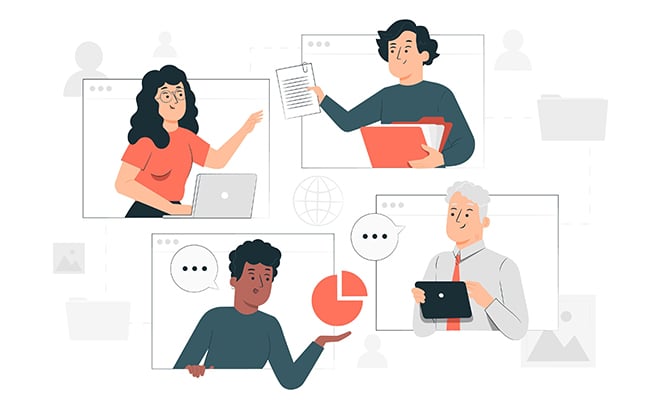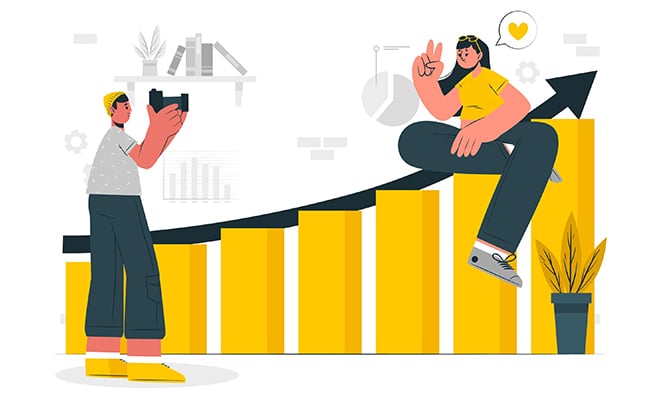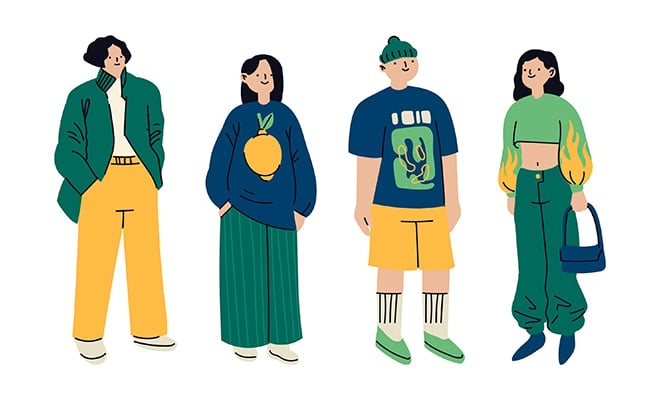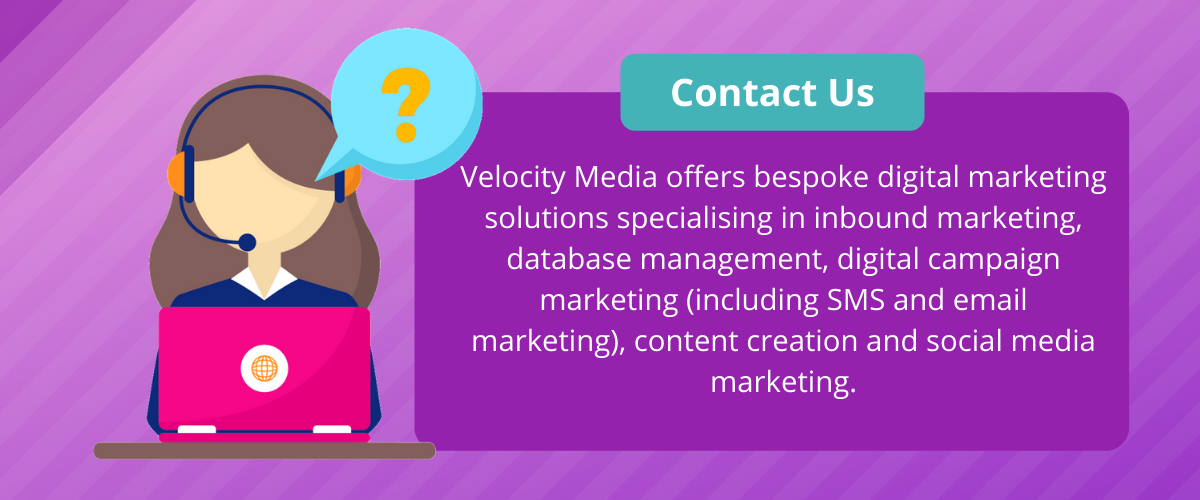Services List
With 2020 shrinking in our rearview mirror, it is time to focus on the road ahead. But to know where we are going, we need to know where we've been. With that in mind, we've put together a trend forecast for the year ahead, and it's going to be an interesting trip around the sun when it comes to the marketing world.
As digital marketers, we've always been accustomed to working closely with people. Be it in collaboration with multiple departments in our own companies or brainstorming buyer personas with clients, it's in our blood to adopt, adapt and improve. While physical distancing is becoming the norm worldwide, we need to apply those rules in almost all aspects of our marketing strategies. So, to better understand what to expect or pay close attention to in 2021, we've compiled it all into a neat list for you to keep close by.
Virtual Events
Mainlining Virtual Events Into The Marketing Funnel
Last year was filled to the brim with virtual events taking place on social media and video streaming sites, and we've seen marketers adapt to this very quickly. Whether people are creating or consuming it, streaming content has been a prime source of escapism for many during the pandemic, and leaning on this as part of a marketing campaign – be it product placement in live music streams or even webinars, we're keeping an eye on this one.
Conferencing Is Going Virtual And It's About Time
The era of anchoring marketing around a big, industry event is coming to a close. We've all seen the annual conference and trade show go virtual, and there's nothing but an upward trajectory moving forward in this realm. Companies should be ready to be active contributors and bring practical value to the conversation, perhaps even host their own digital conferences.
Businesses will find new ways to encourage online connections
If 2020 has taught us one thing, it is that Zoom fatigue is real. In fact, we are all feeling a little digital exhausting brought on not only by meetings in general but with doomscrolling becoming more detrimental to our mental health. With this comes a new challenge, how do you encourage online connections?
The answer is online communities — how do you engage before, during, and after your event? We need to find ways to better engage our audiences and build meaningful connections between our organisations and our customers. We are seeing the demand for engagement already this year and this will continue to be a big trend through 2021.
The interactivity that's been promised for decades is now a necessity for 2021
Jake Milstein, CMO at CI Security, told me: "When the pandemic hit, there was a huge spike in registrations and attendance in virtual events that attempted to mimic in-person events. Attendance at those events lasted a month or two and then dropped off quickly. People are looking for more human interactions — something out of the norm. Webinars just don't do it anymore."
"People are now interested in discussions and panels in which they can ask questions, they can be part of the action, they can offer their own expertise. That's not something you could do when watching someone on-stage, but we all know it's something you can do online. The interactivity that's been promised for decades is now a necessity for 2021."

Brand Values
Customer-centric values Have Moved To The Top Of The List
Last year, revenue teams have been able to weather the storms and thrive by putting the customer at the centre of every decision. And we all know that this is only obtainable if sales, marketing, and customer teams are completely and utterly in sync.
While conventional methods of relationship building, like in-person meetings, may not be possible in the foreseeable future, entering 2021 provides us a paradigm shift for bringing relationships and shared business goals to the forefront of every opportunity.

Revenue and Budget
Say goodbye to A/B testing
Let's take this a step further and protect this trend beyond 2021 and say it'll be fazed out within this decade. Before 2021, we will see the end of A/B testing. Marketers have long relied on validating their intuition with A/B tests to guide creative advertising and marketing decisions — however, the rise of AI makes this not only obsolete, but wasteful... who knows, perhaps this could be the rise of the machines and we get to hang out with John Connor... sorry, we had to throw in a Terminator reference in there.
Digital marketing spend is going up
As we spend more and more time in doors, glued to our computer, TV and smartphone screens, we will consume more content than ever before. With this we've found a digital innovation gap between what customers demand and what brands are currently capable of delivering. That's why digital leaders across industries tell us they plan to spend, on average, 25% more on digital in 2021. And 25% is just the average — some plan to spend significantly more. The take away from this is a bitter pill to swallow: CMOs who aren't scaling up their digital spending will soon be outpaced by competitors.
Enterprises will start spending on tech again
Some companies will keep working from home, others will move to hot desks, and some will — sooner or later — go back to the conventional office space. In 2020 we saw user searches jump on TrustRadius for software categories like e-signature, collaboration, video conferencing, endpoint security, antivirus, and of course telemedicine. Those categories will stay strong in 2021 and beyond, reflecting the new workplace. But it's not all good news as we predict that categories such as event management and facilities management, will have to radically reinvent themselves, if they haven't started doing so already.
Conversations will kick start Content Marketing
It's time to reinvent the way we do content marketing - and it's about time that we do. The marketing industry are still focusing on SEO-heavy blog posts as the main tactic to captivate their audience. There's nothing wrong with using keyword research as a way to get your message across but the problem lies in the fact that it's a strategy made for Google, not for people. Our audiences are craving authentic experiences. The best way to pull this off is by leading the conversation.
As marketers aim to create a more human-centric experience, we will see more content pulled from actual conversations with people in the industry who can provide that genuine interaction today's consumers are looking for," Lindsay Tjepkema, CEO of Casted, told me.

Teams and Collaboration
People Take Front Stage In 2021
2020 caused a cosmic shake and marketing's been assigned a new north star: people. Our trade has always been about understanding people and acting on that knowledge. A key difference in 2021 is that marketers are able to know more than ever. It's the rise of the psychologist, and the rise of the digital marketer.
Rise Of The Web Operations Department
We will require technology to enable real-time responsiveness to customer needs that span the customer lifecycle and each customer touch point. The events of 2020 taught us that we must demand the agility to pivot or transform on a moment's notice to respond to customer and client needs.
In 2021, those will be figments of the past, replaced by cross-functional teams that collaborate through technology-enabled workflows to continuously test, learn, and evolve their digital customer experience. These Web Ops teams will have a distinct advantage — especially those supported by artificial intelligence, machine learning, and automation.

Digital Transformation
Brands will unlock the key to orchestration
We've been saying it for years and in 2021, people are finally starting to listen! Data should be at the top of the priority list this year, but not in the way it usually is. B2B marketers must realise they're generally strong with orchestrating their own data, but weak with third-party data — which must be a top area of focus. They can't afford to depend on marketing automation or CRM platforms for this, but will need to strongly consider creating their own system, something along the lines of a CDP. This is the key to data city in 2021.
Panic pivot? More like purposeful reinvention
Last year, out of pandemic-induced necessity, the industry rapidly transformed face-to-face events into virtual ones, and developed innovative ways of connecting with audiences digitally. In 2021, this reactionary 'panic pivot' will turn to more purposeful reinvention of the ways we engage our core audiences. That reinvention will manifest in hybrid audience experiences that are wholly connected across the communications ecosystem.
Brands Grow With Change
We foresee that the next 12 months will serve up significant opportunities for companies to expand market share. Many companies will fall into the trap that there will be a post-2020 'return to normal.' Everything has been changed, whether it's work-from-home, education, online retail, and more.
The best in the business will look to capitalise further on those changes in 2021, while others unfortunately revert to the old pre-COVID playbooks. It's a great time for marketers to further embrace change, and be the stewards of helping their companies grow and gain share in 2021!
True personalisation needs to be embraced
Oftentimes it's quicker batching and blasting out marketing automations, ignoring personalisation completely. When marketers use intent data and data-based insights to fuel their automated communications, they can create remarkable brand experiences sophisticated consumers rely upon. In the year ahead, marketers will better incorporate real, true personalisation.
Deep data and machine learning is the way to your prospect's heart
The next generation of personalisation is not about cookies or third-party data, it's not about merchandising, and it's not about guesswork. Don't get us wrong, all of those things are important and form part of the bigger picture, but we're rewriting the marketing playbook here. Next gen. personalisation sturdies itself against deep data insights, first and zero-party data and using machine learning to the right sequence of events that leads to an automated path to conversion - personalisation on a whole new level.
The next generation of personalisation is about providing a value exchange for consumers in the 'moment' when you have them on your mobile app, on your site, in your store. How can you provide them something that will generate trust and affinity with the brand?
Cross-channel integrations will Steadily Rise
Incorporating multiple channels within campaigns is much more effective than simply putting all your resources into one channel — even a versatile channel like SMS. It's why we'll see channels and varying tactics continue to cross-integrate in the coming year.
A great example of this would be, channels adopting services like loyalty programs to better connect brands with customers through a variety of strategies within just one platform. Also, a customer interaction in one channel could trigger a personalised, automated sequence in another, creating data- and behavior-driven campaigns many are unable to produce currently due to a lack of time, money and expertise.
It's pedal to the metal with a digital-first shift
We saw an acceleration in the shift to digital in 2020, mainly due to the gap left by live events. Substitutes like virtual conferences lacked the ability to really engage audiences, making them glorified webinars, exacerbating the 'Zoom' fatigue.
We see this trend continuing in 2021 as we look for more creative ways to engage customers and prospects through hyper-personalized outreach, high impact direct mail, intimate and interactive virtual experiences, and relevant educational content.



-Jan-22-2024-11-01-03-2731-AM.png?width=1200&name=CRM%20System%20(1)-Jan-22-2024-11-01-03-2731-AM.png)

